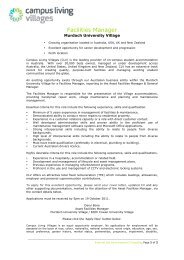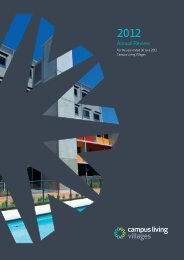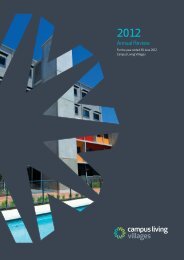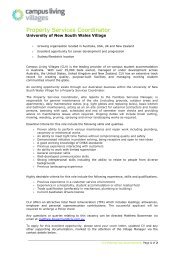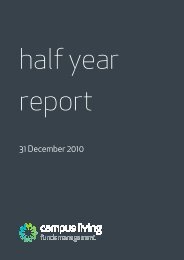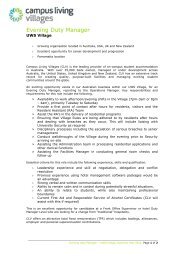Annual Report - Campus Living Villages
Annual Report - Campus Living Villages
Annual Report - Campus Living Villages
Create successful ePaper yourself
Turn your PDF publications into a flip-book with our unique Google optimized e-Paper software.
1 1 6 <strong>Campus</strong> <strong>Living</strong> <strong>Villages</strong> <strong>Annual</strong> <strong>Report</strong> 09/10<br />
<strong>Campus</strong> <strong>Living</strong> Overseas Trust<br />
NOTES TO THE CONSOLIDATED FINANCIAL STATEMENTS<br />
FOR THE YEAR ENDED 30 JUNE 2010<br />
A$’000<br />
CLOT<br />
Consolidated entity companies<br />
The results and financial position of all of the subsidiaries<br />
of the consolidated entity that have a functional currency<br />
different from the presentation currency are translated into<br />
the presentation currency as follows:<br />
> > Assets and liabilities for each balance sheet presented<br />
are translated at the closing rate at the date of that<br />
balance sheet;<br />
> > Income and expenses for each income statement are<br />
translated at average exchange rates (unless this is not a<br />
reasonable approximation of the cumulative effect of the<br />
rates prevailing on the transaction dates, in which case<br />
income and expenses are translated at the dates of the<br />
transactions); and<br />
> > All resulting exchange differences are recognised as a<br />
separate component of equity.<br />
Goodwill and fair value adjustments arising on the acquisition<br />
of a foreign entity are treated as assets and liabilities of the<br />
foreign entities and translated at the closing rate.<br />
d) Revenue recognition<br />
Revenue is measured at the fair value of the consideration<br />
received or receivable. Amounts disclosed as revenue are net<br />
of discounts and refunds.<br />
Management and development fees<br />
Income is recognised when services have been provided to<br />
a customer in accordance with terms prescribed in formal<br />
Operating Agreements and Development Contracts.<br />
Interest<br />
Interest income is recognised on a time proportion basis<br />
using the effective interest method. When a receivable is<br />
impaired, the consolidated entity reduces the carrying amount<br />
to its recoverable amount, being the estimated future cash<br />
flow discounted at the original effective interest rate of the<br />
instrument, and continues unwinding the discount as interest<br />
income. Interest income on impaired loans is recognised using<br />
the original effective interest rate.<br />
Dividends and distributions<br />
Dividends and distributions are recognised as revenue when<br />
the right to receive payment is established.<br />
e) Income tax<br />
The income tax expense or revenue for the period is the tax<br />
payable on the current period’s taxable income based on the<br />
national income tax rate (or State tax rates for US operations)<br />
for each jurisdiction adjusted by changes in deferred tax<br />
assets and liabilities attributable to temporary differences<br />
and to unused revenue tax losses.<br />
The consolidated entity recognises revenue when the amount<br />
of revenue can be reliably measured, it is probable that future<br />
economic benefits will flow to the entity and specific criteria<br />
have been met for each of the consolidated entity’s activities<br />
as described below. The amount of revenue is not considered<br />
to be reliably measurable until all contingencies relating to<br />
the sale have been resolved. The consolidated entity bases its<br />
estimates on historical results, taking into consideration the<br />
type of customer, the type of transaction and the specifics of<br />
each arrangement.<br />
Revenue is recognised for the major business activities<br />
as follows:<br />
Accommodation rental revenue<br />
Accommodation rental revenue is recognised on a time<br />
proportion basis in income on a straight line basis over the<br />
lease term. Revenue received in advance is carried as a liability<br />
on the balance sheet.<br />
Other accommodation related revenue<br />
Other accommodation related revenue is recognised when<br />
the service has been provided or goods have been sold<br />
to the customer. Other accommodation related revenue<br />
typically includes income from catering, conferences, casual<br />
accommodation and other incidental fees.<br />
Deferred income tax is provided in full, using the liability<br />
method, on temporary differences arising between the tax<br />
bases of assets and liabilities and their carrying amounts in<br />
the consolidated financial statements. However, the deferred<br />
income tax is not accounted for if it arises from initial<br />
recognition of an asset or liability in a transaction other than<br />
a business combination that at the time of the transaction<br />
affects neither accounting nor taxable profit or loss. Deferred<br />
income tax is determined using tax rates (and laws) that have<br />
been enacted or substantially enacted by the balance sheet<br />
date and are expected to apply when the related deferred<br />
income tax asset is realised or the deferred income tax<br />
liability is settled.<br />
Deferred tax assets are recognised for deductible temporary<br />
differences and unused tax losses only if it is probable that<br />
future taxable amounts will be available to utilise those<br />
temporary differences and losses.<br />
Deferred tax liabilities and assets are not recognised for<br />
temporary differences between the carrying amount and tax<br />
bases of investments in controlled entities where the parent<br />
entity is able to control the timing of the reversal of the<br />
temporary differences and it is probable that the differences<br />
will not reverse in the foreseeable future.



